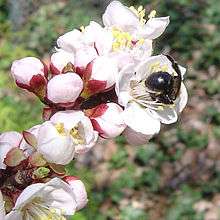Prunus mandshurica
| Prunus mandshurica | |
|---|---|
 | |
| Manchurian apricot blossoms with bee | |
| Scientific classification | |
| Kingdom: | Plantae |
| (unranked): | Angiosperms |
| (unranked): | Eudicots |
| (unranked): | Rosids |
| Order: | Rosales |
| Family: | Rosaceae |
| Subfamily: | Amygdaloideae |
| Genus: | Prunus |
| Species: | P. mandshurica |
| Binomial name | |
| Prunus mandshurica (Maxim.) Koehne | |
| Synonyms[1] | |
| |
Prunus mandshurica, called Manchurian apricot and Scout apricot, is a tree in the genus Prunus. It was first described by Karl Maximovich in 1883 as a variety of the Siberian apricot (Tibetan apricot) Prunus armeniaca.[2] It is resistant to cold and is native to northeast China, Korea, and Manchuria.[3] It is highly susceptible to plum pox potyvirus.[4]
Description
Prunus mandshurica is a deciduous, broad-leaved tree which grows to a height of about 10 meters (33 ft). The inner bark is red and the outer bark is black. The leaves are oval, with an elongated tip (acuminate or caudate), some hairs and serrated edges. The tree grows best in loam soils. Its petioles are 3 centimeters (1.2 in). The sepals and petals are oval, while the length of the stamens is similar to that of the stigma, which is cup-shaped. Flowers appear in spring and are white or pale pink. Fruits appear in late summer and are yellow with some red. In the autumn the leaves turn golden orange.[5][6][7][8]
Uses
Seed oil from P. mandshurica has been studied as a source of biodiesel. The oil content of Prunus sibirica seeds is significantly lower but also has potential as a source of biodiesel. It has been used in cosmetics, soaps, and cold creams, and is also a source of the antimicrobial phloretin. Practitioners of traditional Chinese medicine believe that the dried kernels are useful for treating asthma and constipation.[6][9][10][11][12][13]
Cultivars
Cultivars include the 'Mandan', hybrids 'Moongold' and 'Sungold',[6] and var. glabra.[2]
Nomenclature
In China, it is known as the northeastern apricot (Chinese: 东北杏) or Liaoning apricot (Chinese: 辽杏)–both names describe the geographical position of Manchuria. In Korean, it is known as the Gaesalgu tree (개살구나무).
References
- ↑ GRIN (April 10, 2012). "Prunus mandshurica L.". Taxonomy for Plants. National Germplasm Resources Laboratory, Beltsville, Maryland: USDA, ARS, National Genetic Resources Program. Retrieved February 3, 2014.
- 1 2 GRIN (April 10, 2012). "Prunus armeniaca L. var. mandshurica Maxim.". Taxonomy for Plants. National Germplasm Resources Laboratory, Beltsville, Maryland: USDA, ARS, National Genetic Resources Program. Retrieved January 30, 2014.
- ↑ Das, Biswajit; Ahmed, N.; Singh, Pushkar (2011). "Prunus diversity - Early and Present Development: A Review" (PDF). International Journal of Biodiversity and Conservation. 3 (14): 721–734. doi:10.5897/IJBCX11.003.
- ↑ Dicenta, F.; Rubio, M.; Martinez-Gomez, P. (2006). "Susceptibility to Sharka (Plum Pox Potyvirus) in Prunus mandshurica x Prunus armeniaca Seedlings". Acta Horticulturae. 701: 223–226.
- ↑ Cuizhi Gu; Chaoluan Li; Lingdi Lu; Shunyuan Jiang; Crinan Alexander; Bruce Bartholomew; Anthony R. Brach; David E. Boufford; Hiroshi Ikeda; Hideaki Ohba; Kenneth R. Robertson & Steven A. Spongberg (2003). "Flora of China online". eFlora.
|chapter=ignored (help) - 1 2 3 "Manchurian Apricot (Prunus armeniaca var. mandshurica)" (PDF). North Dakota State University. Retrieved January 30, 2014.
- ↑ Wilson, Ernest Henry (1920). The Romance of our Trees. Garden City, NY: Doubleday, Page, and Co. p. 214.
- ↑ "Prunus mandshurica" (PDF). Arnoldia. Arnold Arboretum, Harvard University. 3 (2). 1917.
- ↑ Acton, Ashton (2013). Issues in Fossil Fuel Engergy Technologies. Atlanta: Scholarly Editions. p. 424. ISBN 978-1-490-10684-7.
- ↑ Wang, Libing; Yu, H. (2012). "Biodiesel from Siberian Apricot (Prunus sibirica L.) Seed Kernel Oil". Bioresource Technology. 112: 355–358. doi:10.1016/j.biortech.2012.02.120. PMID 22440572.
- ↑ Wang, Libing (2013). "Properties of Manchurian apricot (Prunus mandshurica Skv.) and Siberian apricot (Prunus sibirica L.) Seed Kernel Oils and Evaluation as Biodiesel Feedstocks". Industrial Crops and Products: 838–843. doi:10.1016/j.indcrop.2013.08.072.
- ↑ Xinrong, Yang (2003). Encyclopedic Reference of Traditional Chinese Medicine. Berlin: Springer-Verlag. p. 26. ISBN 3-540-42846-1.
- ↑ Russo, Ethan B.; Hou, Joseph (2005). The Healing Power of Chinese Herbs and Medicinal Recipes. Binghampton, NY: Haworth Press. pp. 364–365. ISBN 0-7890-2202-8.
External links
| Wikimedia Commons has media related to Prunus_mandshurica. |
| Wikispecies has information related to: Prunus_mandshurica |